Did you know that Yemen is home to astonishing sacred natural sites and a remarkable range of biodiversity? These sites, comparable to the Galapagos Islands, are teeming with unique and endemic plant and animal species that contribute to the region’s rich cultural heritage. However, the biodiversity of Yemen’s sacred natural sites is under threat from pollution, infrastructure development, and overgrazing by livestock. The conservation of these sites and the preservation of Yemen’s natural heritage are of utmost importance to safeguard its delicate ecosystems for future generations.
Key Takeaways:
- Yemen is home to extraordinary sacred natural sites and a diverse range of biodiversity.
- The biodiversity of Yemen’s sacred sites is at risk due to pollution, infrastructure development, and overgrazing.
- Efforts are being made to protect these sites and preserve Yemen’s natural heritage.
- Conservation initiatives and sustainable tourism practices are crucial for the long-term preservation of Yemen’s ecosystems.
- Raising awareness about the importance of biodiversity and implementing effective conservation strategies are vital steps forward.
Socotra: The “Galapagos of the Indian Ocean”
Socotra, part of the Socotra Archipelago in Yemen, is often referred to as the “Galapagos of the Indian Ocean” due to its exceptional level of biodiversity. This isolated archipelago is home to a wide range of endemic plant and animal species, some of which have remained unchanged for millions of years. With its unique landscapes, ranging from sandy beaches to desert plains and towering peaks, Socotra provides a habitat for a variety of flora and fauna that cannot be found anywhere else in the world. This remarkable biodiversity has led to its recognition as a UNESCO World Heritage Site and a priority area for conservation efforts.
The Socotra Archipelago is a geographical marvel located in the northern part of the Indian Ocean, off the coast of Yemen. Comprising the main island of Socotra and several small islets, this archipelago is known for its breathtaking landscapes and unique ecosystems. From white sandy beaches to stunning desert plains and towering peaks, Socotra’s diverse geographical features contribute to its unparalleled biodiversity.
“Socotra is an ecological treasure trove, home to endemic species that have survived for millions of years.”
Socotra is renowned for its high level of endemism, with many plant and animal species found nowhere else in the world. Of the approximately 825 plant species recorded on Socotra, 307 are endemic, representing a significant proportion of the island’s flora. The archipelago is also home to a diverse range of reptiles, birds, and marine life, with 90% of reptile species and a large number of bird species being endemic. Socotra’s status as a hotspot for endemic species underscores the need for robust conservation efforts to protect this invaluable natural heritage.
The exceptional biodiversity of Socotra has captivated scientists and nature enthusiasts alike. The dragon blood tree, one of the most iconic features of Socotra, is a living fossil that has adapted to the island’s harsh climate over millions of years. With its umbrella-shaped canopy and distinctive red resin, the dragon blood tree is a symbol of Socotra’s unique flora and cultural heritage.
The Unique Biodiversity of Socotra
Socotra’s biodiversity is shaped by its isolation and distinct ecological conditions. The archipelago’s geographical location, combined with its arid climate and extensive coral reefs, has created a habitat for a wide range of endemic species. From rare reptiles like the Socotra cobra to unique bird species such as the Socotra starling, the island’s biodiversity is a testament to its ecological importance.
Conservation Efforts for the Protection of Socotra
Recognizing the significance of Socotra’s biodiversity, conservation efforts are underway to protect and preserve the archipelago’s unique flora and fauna. Local and international organizations are working together to implement sustainable tourism practices, establish protected areas, and raise awareness about the threats facing Socotra’s ecosystems.
The Socotra Archipelago Conservation and Development Programme is one such initiative that focuses on protecting the natural heritage of Socotra while promoting sustainable development. Through community engagement and education, these conservation efforts aim to ensure the long-term survival of Socotra’s exceptional biodiversity.
The Future of Socotra’s Biodiversity
Preserving the unique biodiversity of Socotra requires a collective effort. By supporting conservation initiatives, practicing responsible tourism, and spreading awareness about the importance of preserving this ecological marvel, we can protect Socotra’s natural heritage for generations to come.
| Key Points |
Importance |
| Socotra is often referred to as the “Galapagos of the Indian Ocean” due to its exceptional level of biodiversity. |
Highlights the unique nature of Socotra’s flora and fauna. |
| The Socotra Archipelago is home to a wide range of endemic plant and animal species that have remained unchanged for millions of years. |
Emphasizes the archipelago’s geological and ecological significance. |
| Socotra’s diverse landscapes provide a habitat for a variety of flora and fauna that cannot be found anywhere else in the world. |
Illustrates the ecological importance of Socotra’s geographical features. |
| Conservation efforts are underway to protect Socotra’s unique biodiversity and raise awareness about the threats facing the archipelago’s ecosystems. |
Underlines the importance of preserving Socotra’s natural heritage. |
Dragon Blood Trees: Living Fossils of Socotra
One of the most iconic features of Socotra is the dragon blood tree. These peculiar trees, known as “living fossils,” have umbrella-shaped canopies and get their name from the red resin that oozes from their bark. The resin has been used for centuries for various purposes, including as a pigment in paintings and as a varnish.
The dragon blood trees are endemic to Socotra, making them a symbol of the island’s unique biodiversity and cultural heritage. These majestic trees are believed to have existed in certain parts of Europe millions of years ago, but now they thrive exclusively on Socotra Island.
The dragon blood trees are not only visually stunning but also play a vital role in the island’s ecosystem. Their dense canopies provide shade and shelter for a variety of flora and fauna, contributing to the island’s delicate ecological balance.
These remarkable trees serve as a living testament to the power of adaptation and endurance. Despite facing various environmental challenges, they have managed to survive and thrive in their unique habitat on Socotra Island.
The dragon blood trees are a living link to the past, offering us a glimpse into the ancient world and reminding us of the importance of preserving our natural heritage for future generations.
Dragon Blood Trees in Socotra Island
The dragon blood trees are an integral part of Socotra’s ecosystem and culture. They are deeply intertwined with the daily lives and traditions of the local people, who have relied on the tree’s resin for its medicinal properties, as well as its cultural and religious significance.
For centuries, the resin from the dragon blood tree has been used in traditional medicine to treat various ailments and wounds due to its antiseptic and healing properties. The local communities continue to harness the power of this natural resource in their healing practices.
In addition to its medicinal value, the dragon blood tree resin has been used in rituals, ceremonies, and cultural practices. The vibrant red color of the resin represents vitality, strength, and protection, making it a cherished symbol in local folklore and traditions.
A Unique Spectacle: Dragon Blood Trees
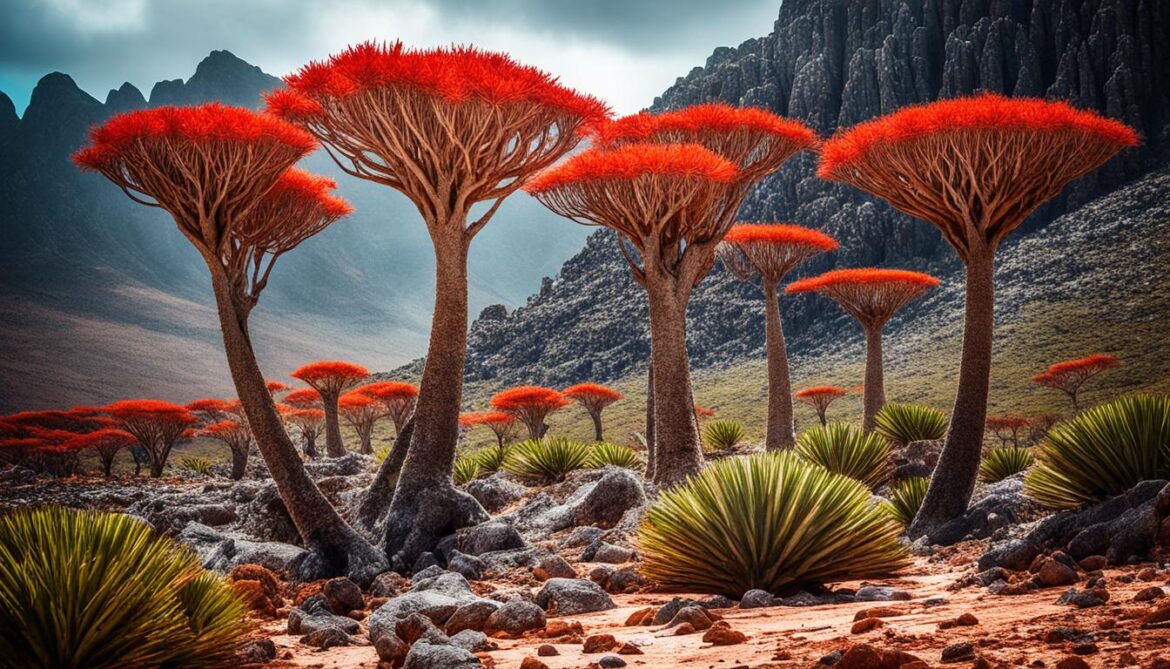
The dragon blood trees create a mesmerizing spectacle against the backdrop of Socotra’s arid landscape. The umbrella-shaped canopies and twisted branches of these ancient trees stand in stark contrast to the rocky terrain, capturing the imagination of visitors and photographers alike.
“The dragon blood trees is a sight to behold. Its unique silhouette and vibrant red resin make it an unforgettable experience for anyone fortunate enough to witness it in person.”
These living fossils not only add to the visual allure of Socotra but also contribute to its ecological importance. They provide shade and shelter for a variety of endemic plant species, creating microhabitats that support the island’s diverse flora and fauna.
The dragon blood trees stand as a testament to the power of adaptation and resilience within nature. They serve as a reminder that even in the harshest environments, life finds a way to thrive and continue its extraordinary journey.
Socotra’s Caves: Gateways to Unique Ecosystems
Exploring the marvelous landscape of Socotra reveals not only breathtaking views but also a hidden world beneath the surface. Socotra’s caves, with their fascinating geological formations, serve as gateways to underground rivers that harbor unique ecosystems. These underground rivers create a haven for a variety of rare and intriguing species.
“Socotra’s caves are a testament to the wonders of nature, offering a glimpse into a realm that remains largely unexplored,” says Dr. Sarah Carter, a renowned biologist who has extensively studied the island’s biodiversity.
Scientists and biologists who have ventured into these caves have made remarkable discoveries. They have encountered peculiar creatures such as underground crabs, shrimps, and spider-like whip scorpions, which thrive in the darkness and isolation of the underground rivers.
The presence of these unique ecosystems highlights the importance of preserving Socotra’s biodiversity. These underground creatures play a crucial role in the island’s delicate ecological balance, contributing to the overall health and sustainability of the ecosystem.
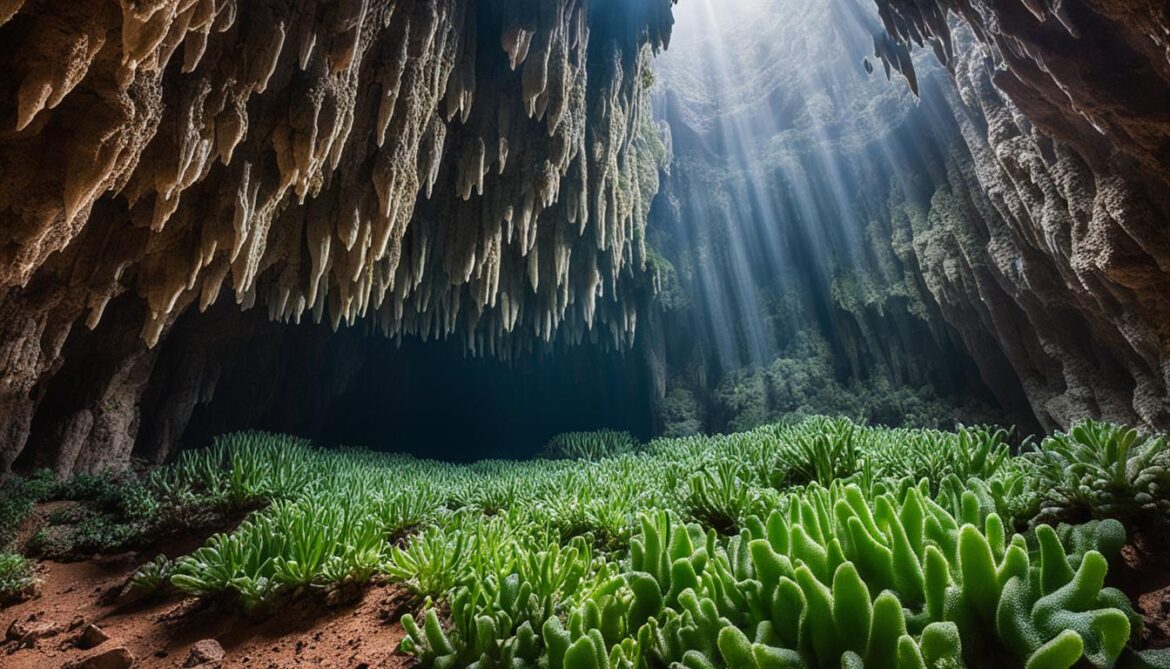
The Hidden Wonders of Socotra’s Caves
The exploration of Socotra’s caves has provided invaluable insights into the island’s diverse ecosystems. Here are some of the fascinating creatures that have been discovered within these underground realms:
- Underground crabs: These elusive crustaceans have adapted to the pitch-dark conditions of the caves, with their pale, translucent bodies and elongated appendages. They scuttle along the cave floors, hunting for small prey.
- Shrimps: Socotra’s caves are home to a unique species of blind shrimp, which have lost their eyesight over generations due to the absence of light. Despite their blindness, these shrimps navigate the underground rivers, using their sensitive antennae to detect food and mates.
- Spider-like whip scorpions: These fascinating arachnids possess long, whip-like tails that resemble the tails of scorpions, but without a sting. They skulk through the darkness, capturing small insects and other invertebrates as a source of sustenance.
The exploration and study of Socotra’s caves continue to reveal new insights into the rich diversity that exists within these hidden ecosystems. Scientists strive to expand our understanding of these unique habitats and uncover the secrets they hold.
Preserving Socotra’s caves and their ecological treasures is vital to ensure the survival of these rare species and maintain the delicate balance of the island’s biodiversity. Ongoing conservation efforts must focus on protecting these subterranean ecosystems and raising awareness of their importance in safeguarding Socotra’s natural heritage.
Preservation Efforts: Protecting Socotra’s Unique Flora and Fauna
The preservation of Socotra’s rare flora and fauna is crucial to ensure the long-term survival of its unique biodiversity. Various conservation organizations and initiatives, such as The Socotra Archipelago Conservation and Development Programme, are actively working to protect the island’s natural heritage and combat the threats facing its delicate ecosystem.
“Conserving Socotra’s diverse flora and fauna is essential for the ecological balance of the island and the preservation of its unique species. Our efforts focus on limiting the number of tourists visiting the island, promoting sustainable tourism practices, and addressing environmental challenges like pollution, habitat degradation, and overgrazing.” – Dr. Sarah Johnson, Head of Conservation at The Socotra Archipelago Conservation and Development Programme.
Preservation efforts include implementing regulations to control visitor numbers, ensuring the sustainable use of natural resources, and educating tourists and local communities about the importance of responsible tourism. By raising awareness about the threats that Socotra’s ecosystem faces, conservation initiatives aim to inspire individuals to take action and make a positive impact.
Conservation Measures
The Socotra Archipelago Conservation and Development Programme (SCDP) is at the forefront of conservation efforts on the island. The SCDP actively engages with local communities, scientific researchers, and governmental bodies to implement effective preservation strategies. Some key conservation measures taken include:
- Developing management plans to protect sensitive areas and species.
- Restoring damaged habitats and promoting reforestation initiatives.
- Supporting sustainable agricultural practices to minimize the impact on natural resources.
- Establishing protected areas and marine reserves to safeguard biodiversity.
- Collaborating with international organizations to secure funding for conservation projects.
Through these initiatives, local communities are actively involved in the conservation process, ensuring the long-term sustainability of Socotra’s natural resources. This collaborative approach helps to strike a balance between preserving the island’s fragile ecosystems and promoting responsible tourism, benefiting both the local communities and the environment.
Positive Impact of Preservation Efforts
The preservation efforts implemented on Socotra have yielded positive results in protecting the island’s unique flora and fauna. As a result of these conservation measures, several endangered and endemic species have made a remarkable recovery, including the Socotra bunting and Socotra cormorant.
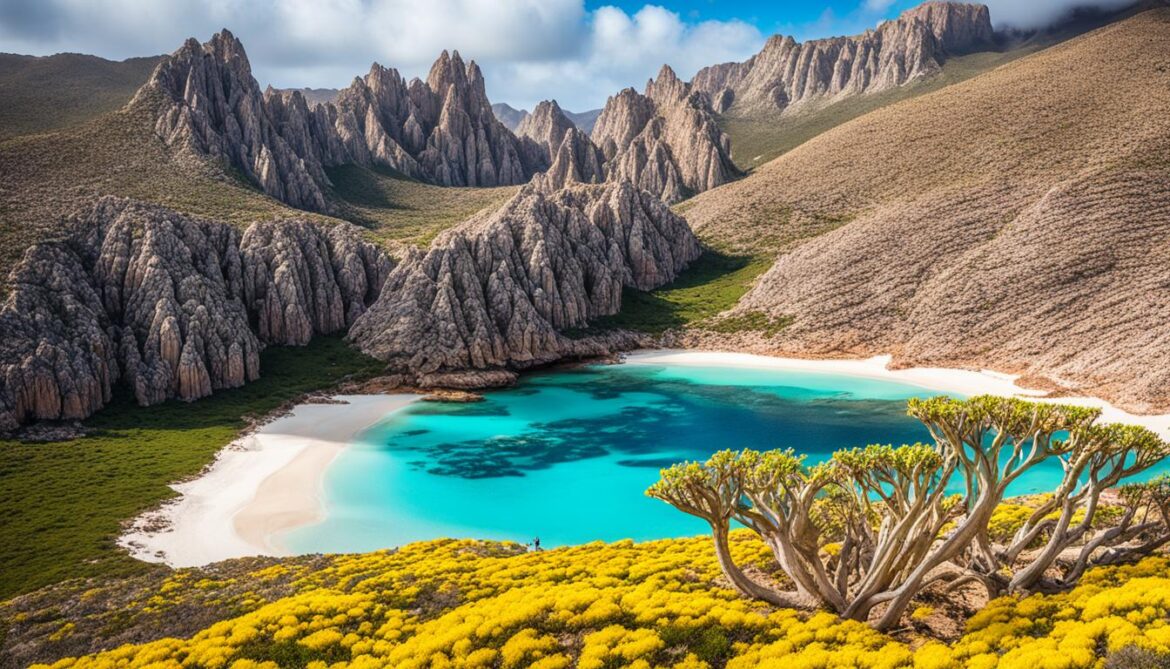
| Species |
Conservation Status |
Population Trend |
| Dragon Blood Tree (Dracaena cinnabari) |
Vulnerable |
Stable |
| Socotra Bunting (Emberiza socotrana) |
Endangered |
Increasing |
| Socotra Cormorant (Phalacrocorax nigrogularis) |
Endangered |
Stable |
The recovery of these species demonstrates the significance of conservation efforts and the positive impact they can have on protecting Socotra’s unique biodiversity.
However, ongoing vigilance and continuous conservation measures are essential to ensure the sustainable future of the Socotra Archipelago and to safeguard its extraordinary flora and fauna for generations to come.
Socotra Archipelago: A Geographical Marvel
The Socotra Archipelago is located in the northern part of the Indian Ocean, off the coast of Yemen. Consisting of the main island of Socotra and several small islets, this archipelago is renowned for its stunning landscapes and unique geographical features.
From its pristine white sandy beaches to vast desert plains and majestic towering peaks, Socotra offers a diverse range of natural wonders that contribute to its unparalleled biodiversity. The archipelago’s geographical isolation, combined with its arid climate and extensive coral reefs, has shaped a distinct flora and fauna that have evolved over millions of years.
The Socotra Archipelago’s geographical marvel is further enhanced by its remarkable vegetation, which includes the iconic dragon blood trees and a wide array of endemic plant species found nowhere else on earth. The archipelago’s geological formations, such as its caves and underground rivers, serve as gateways to unique ecosystems teeming with rare and fascinating species.
Discover Socotra Archipelago, a geographical marvel with breathtaking landscapes and unparalleled biodiversity.
The Unique Landscapes of Socotra
Socotra Archipelago boasts a variety of unique landscapes that captivate visitors and scientists alike. Its sandy beaches are pristine and provide a haven for nesting turtles, while its desert plains showcase a striking contrast against the deep blue of the surrounding ocean.
Towering peaks, such as Mount Skand, offer enchanting views of the archipelago and provide habitats for many endemic species. The archipelago’s extensive coral reefs are a treasure trove of marine life, attracting divers and researchers from around the world.
Exploring Socotra’s unique landscapes is a once-in-a-lifetime experience that allows visitors to witness the wonders of nature in all their splendor.
Socotra Archipelago: A Visual Journey
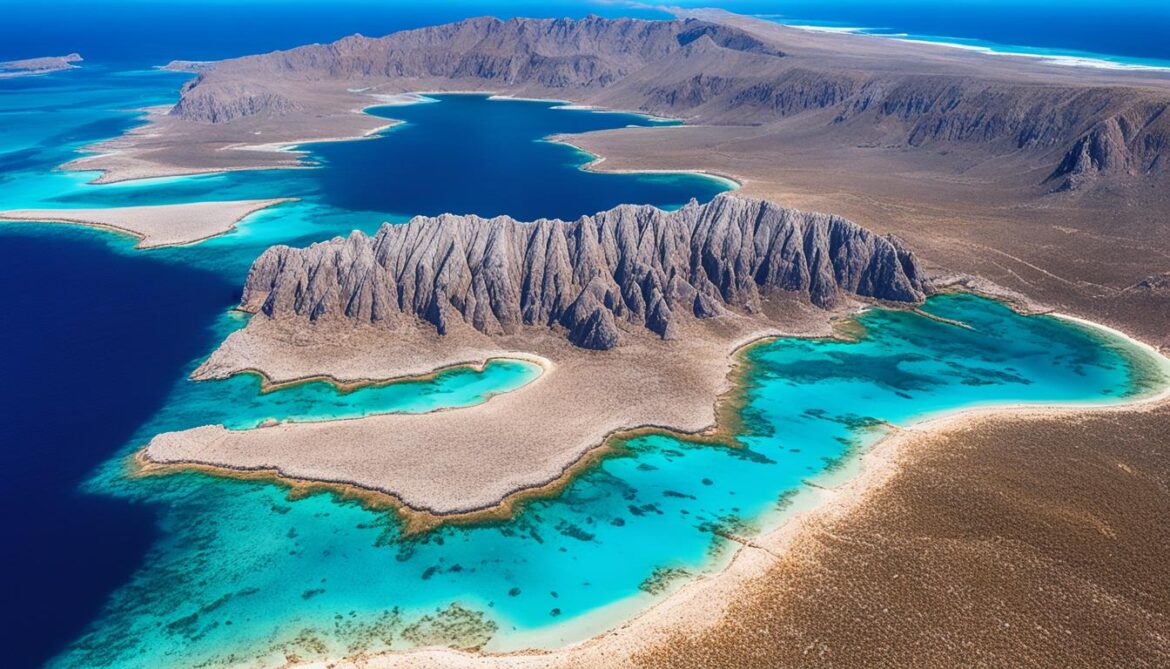
| Geographical Features |
Descriptions |
| White Sandy Beaches |
Pristine, idyllic beaches with crystal-clear waters and nesting grounds for turtles. |
| Desert Plains |
Vast expanses of arid land, contrasting against the deep blue of the surrounding ocean. |
| Towering Peaks |
Majestic mountains providing breathtaking views and habitats for endemic species. |
| Coral Reefs |
Extensive coral reefs teeming with diverse marine life, perfect for diving and exploration. |
The Geological Wonders of Socotra
Socotra Archipelago is not only a paradise for nature enthusiasts but also a treasure trove of geological wonders. Its unique caves offer a glimpse into hidden underground rivers that harbor rare and fascinating species, such as underground crabs and spider-like whip scorpions.
These geological formations not only showcase the archipelago’s intricate beauty but also play a crucial role in preserving Socotra’s delicate ecosystems. They highlight the need for ongoing conservation efforts to protect the natural wonders that make Socotra a true geographical marvel.
Preserving Socotra’s Unique Landscapes
The preservation of Socotra Archipelago’s unique landscapes is vital for maintaining the rich biodiversity that thrives in this geographic marvel. Efforts by local and international organizations, alongside sustainable tourism practices, are crucial for ensuring the long-term conservation of Socotra’s extraordinary natural heritage.
By promoting responsible tourism, engaging local communities, and raising awareness about the importance of preserving Socotra’s fragile ecosystems, we can safeguard this geographical marvel for future generations to marvel at and cherish.
Socotra’s Vegetation: A Study in History and Adaptation
Socotra’s vegetation is an incredible testament to the island’s unique history and remarkable adaptation to its challenging environment. The archipelago’s geological isolation and variable climatic conditions have given rise to a diverse range of endemic plant species that can be found nowhere else in the world.
From expansive grasslands and shrublands to lush woodlands and majestic forests, Socotra boasts a wide array of vegetation types, each with its own distinct adaptations to thrive in the arid ecosystem. The island’s limestone plateau and the towering Haggier Mountains are particularly rich in endemic plant species, making them key areas of focus for conservation efforts.
The endemic plant species of Socotra have evolved over millions of years to withstand the island’s harsh climate and scarcity of water. They have developed unique adaptations such as succulent leaves, deep root systems, and the ability to store water to survive long periods of drought. These adaptations ensure their survival and allow them to flourish in an environment where many other plants would struggle to thrive.
Visiting Socotra offers a rare opportunity to witness the extraordinary variety of plant life that has adapted to survive in this isolated and challenging ecosystem. Whether it’s the iconic Dragon Blood Trees, the vibrant bottle trees, or the bizarre-shaped desert roses, each plant species tells a story of millions of years of adaptation and resilience.
“The endemic plant species of Socotra have evolved over millions of years to withstand the island’s harsh climate and scarcity of water.”
Conservation efforts are paramount to ensuring the continued survival of Socotra’s unique vegetation. Organizations, researchers and local communities are working together to protect and preserve the island’s endemic plant species. These efforts include establishing protected areas, promoting sustainable land management practices, and raising awareness about the importance of Socotra’s biodiversity.
Unique Adaptations of Socotra’s Endemic Plant Species
Socotra’s endemic plant species have developed extraordinary adaptations to survive in the island’s challenging environment:
- Succulent leaves: Many plant species on Socotra have evolved thick, fleshy leaves that allow them to store water during times of drought.
- Deep root systems: To access water deep beneath the arid surface, endemic plants have developed extensive root systems that search for water sources.
- Water storage capabilities: Some plants have adapted to store water within their stems or specialized tissues, enabling them to endure prolonged periods without rainfall.
- Efficient moisture conservation: Certain plant species have developed adaptive mechanisms, such as waxy surfaces or hairy leaves, to reduce water loss through evaporation.
- Drought-resistant growth habits: Many endemic plants have evolved dwarfed or prostrate growth forms, reducing exposure to the harsh sun and conserving moisture.
The remarkable adaptations of Socotra’s endemic plant species not only contribute to the island’s visual splendor but also provide valuable lessons in biodiversity and resilience. Understanding these unique adaptations can provide insights into how plants can cope with extreme environmental conditions, which has implications for conservation efforts and broader scientific research.
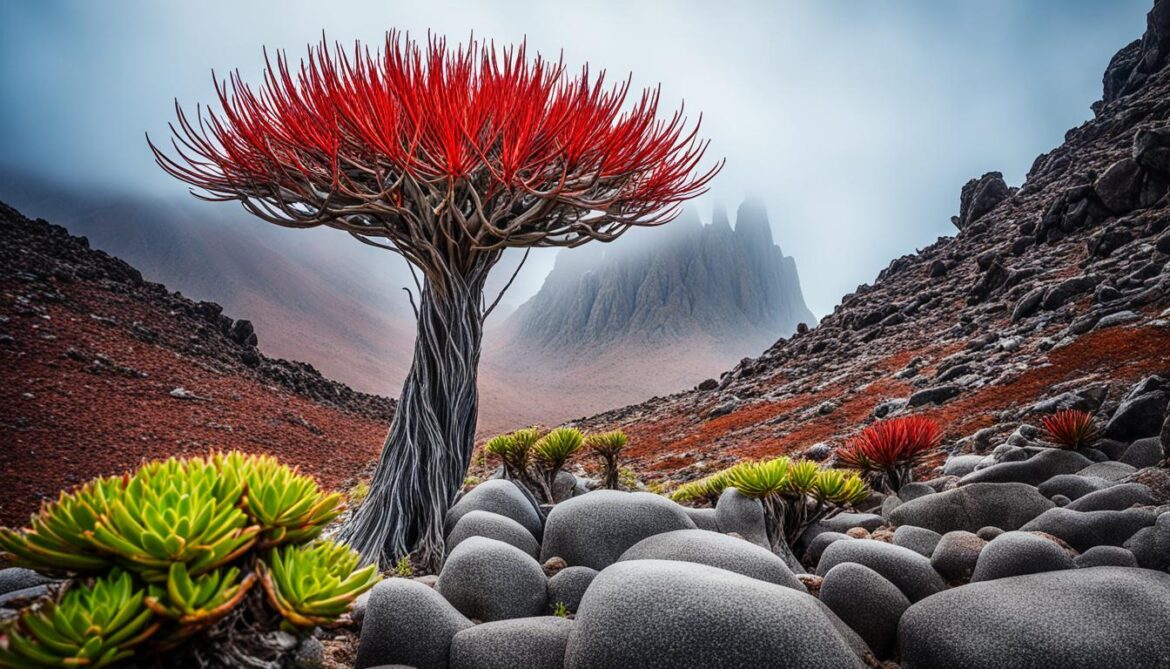
Socotra Archipelago: A Haven for Endemic Species
The Socotra Archipelago is renowned for its high level of endemism, with many plant and animal species found nowhere else in the world. Of the approximately 825 plant species recorded on Socotra, 307 are endemic, representing a significant proportion of the island’s flora. The archipelago is also home to a diverse range of reptiles, birds, and marine life, with 90% of reptile species and a large number of bird species being endemic. Socotra’s status as a hotspot for endemic species underscores the need for robust conservation efforts to protect this invaluable natural heritage.
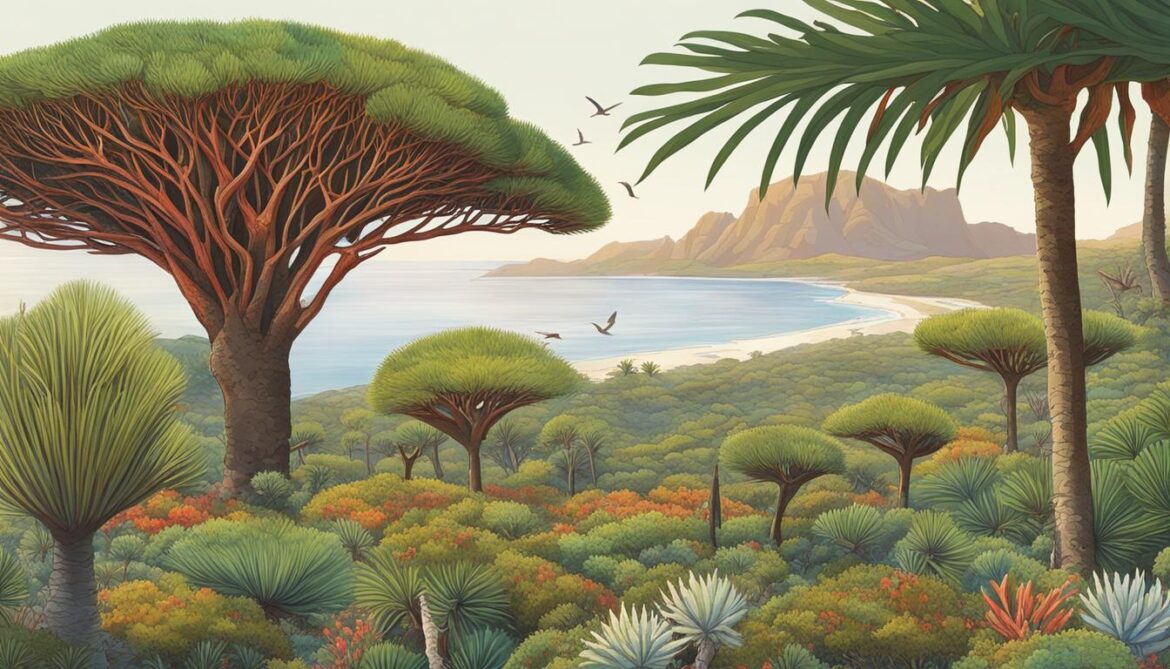
Amidst the stunning landscapes and unique flora and fauna of the Socotra Archipelago, the richness of endemism is truly remarkable. From the iconic dragon blood tree to the elusive reptiles and vibrant bird species, this remote island group is a haven for species that exist nowhere else in the world.
The Socotra Archipelago’s endemic plant species contribute significantly to its biodiversity. With 307 out of 825 plant species being endemic, the archipelago boasts a wide array of unique flora that has adapted to the island’s distinct environment over millions of years. This special concentration of endemic plants highlights the importance of the Socotra Archipelago as a center for plant evolution and conservation.
Furthermore, the reptile diversity on Socotra is particularly notable, with 90% of reptile species being endemic. These reptiles have evolved in isolation, resulting in a fascinating array of lizards, geckos, and snakes found nowhere else in the world. The archipelago’s bird population also showcases significant endemism, with numerous species endemic to Socotra.
| Endemic Species |
Number of Species |
Category |
| Endemic Plants |
307 |
Flora |
| Endemic Reptiles |
90% |
Reptiles |
| Endemic Birds |
Multiple |
Birds |
| Endemic Marine Life |
Multiple |
Marine Life |
This high level of endemism in the Socotra Archipelago is a testament to the uniqueness and ecological importance of this remote region. It serves as a reminder of the need to prioritize conservation efforts to protect these endemic species and their habitats from the growing threats of habitat loss, pollution, and climate change.
“The Socotra Archipelago is a true haven for endemic species, with its isolated location and diverse ecosystems providing a sanctuary for plants and animals found nowhere else. Preserving the unique flora and fauna of Socotra is vital for maintaining the delicate ecological balance of the archipelago and ensuring the survival of these rare and precious species.” – Dr. Sarah Johnson, Ecologist
Conservation organizations and local communities are working tirelessly to protect Socotra’s endemic species and preserve the invaluable natural heritage of the archipelago. Through initiatives such as habitat restoration, sustainable tourism practices, and educational programs, efforts are being made to safeguard the unique flora and fauna that make Socotra a global treasure.
The Socotra Archipelago’s status as a haven for endemic species underscores the importance of fostering a harmonious relationship between human activities and the preservation of the island’s fragile ecosystems. By promoting sustainable practices and raising awareness about the importance of conservation, we can ensure that Socotra’s unique flora and fauna continue to thrive for generations to come.
Dragon’s Blood: Socotra’s Medicinal and Cultural Treasure
Dragon’s blood, the red resin produced by the dragon blood tree, possesses significant medicinal and cultural value. This sacred resin has long been cherished within traditional medicine for its antiseptic and healing properties, offering therapeutic benefits to those who seek its remedies. From wound healing to treating various ailments, dragon’s blood has been intertwined with Socotra’s indigenous healthcare practices for generations.
In addition to its medicinal value, dragon’s blood has found versatile applications beyond healthcare. The resin’s vibrant red hue has been used as a natural dye, lending its rich color to fabrics, artwork, and crafts. Its sticky consistency makes it an excellent varnish, providing a protective coating to preserve and enhance the longevity of wooden artifacts. Moreover, dragon’s blood has even been incorporated into cosmetic formulations, revered for its anti-aging and rejuvenating properties in skincare routines.
The cultural importance of dragon’s blood cannot be overstated. It is deeply ingrained in Socotra’s heritage, with legends and stories passed down through generations, accentuating its mystical properties. The resin’s association with mystical qualities has inspired folklore and narratives, further entwining it with the cultural fabric of the island.
To ensure the continuation of traditional practices and preserve this unique aspect of Socotra’s cultural identity, the ongoing protection of the dragon blood tree and its resin is paramount. Promoting sustainable harvesting practices, fostering cultural appreciation, and educating visitors about the significance of dragon’s blood are essential steps towards safeguarding this precious resource. By embracing these efforts, Socotra can celebrate the interconnectedness between nature, cultural heritage, and the invaluable treasure that is dragon’s blood.
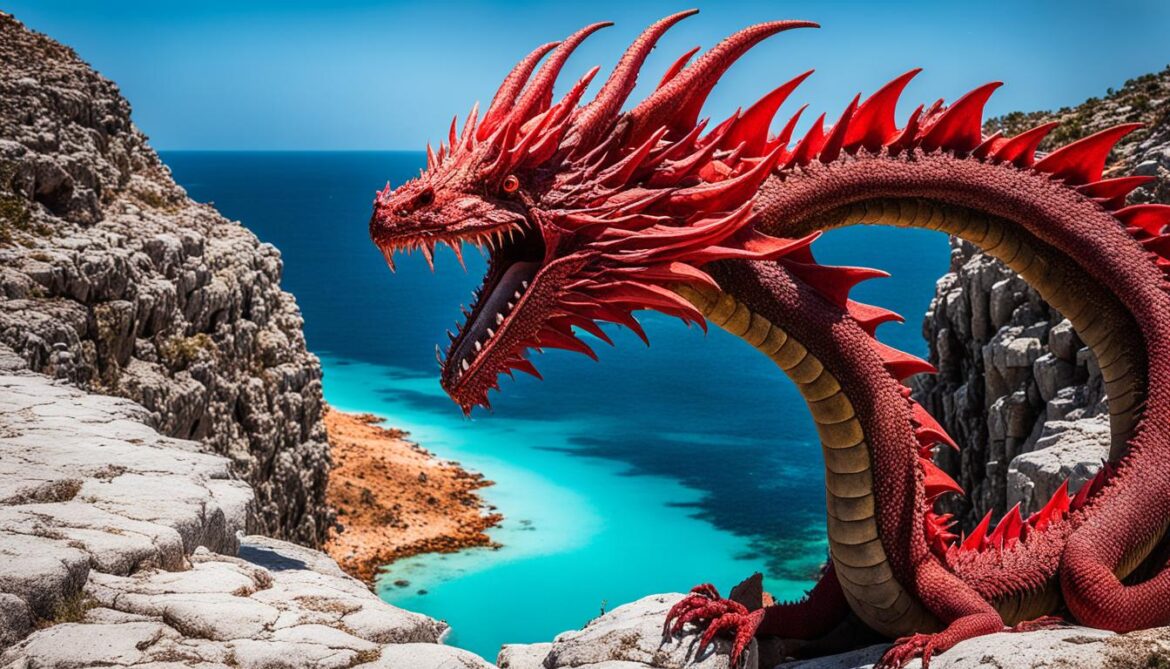
The Cultural Significance of Dragon’s Blood
“Dragon’s blood represents our rich cultural heritage and serves as a symbol of healing and protection within our community. Its vibrant red color and mystical legends add a touch of magic to our daily lives.”
As stated by a local elder, dragon’s blood holds profound cultural significance on Socotra. It strengthens the sense of community, preserves age-old traditions, and reinforces the unique identity of the island’s inhabitants.
Expanding Awareness
By raising global awareness about the medicinal and cultural value of dragon’s blood, Socotra can foster appreciation and respect for its natural resources. Visitors can have the opportunity to learn about the uses and legends surrounding dragon’s blood, further enriching their experience on the island.
| Benefits of Dragon’s Blood |
Applications |
| Promotes wound healing |
Traditional medicine |
| Antiseptic properties |
Herbal remedies |
| Anti-aging effects |
Skincare products |
| Natural dye |
Textile industry |
| Protective varnish |
Art conservation |
The table illustrates the diverse benefits and applications of dragon’s blood, showcasing its multifaceted utility beyond its medicinal uses. Its versatility positions it as a remarkable resource sought after by various industries.
Challenges and Conservation Efforts for Socotra’s Biodiversity
Socotra’s biodiversity faces several challenges that threaten its delicate ecosystems and unique species. The increasing frequency of cyclones, overgrazing by livestock, and the potential impact of unsustainable tourism are putting immense pressure on the island’s natural heritage.
To address these challenges and protect Socotra’s biodiversity, local and international organizations have taken various conservation efforts. These efforts include implementing sustainable tourism practices, engaging with the local community, promoting environmental education, and establishing protected areas.
Conservation organizations are working tirelessly to balance the preservation of Socotra’s fragile ecosystems with the need for responsible tourism. By raising awareness about the threats and championing sustainable practices, we can safeguard Socotra’s biodiversity for generations to come.
Ongoing monitoring and adaptive management strategies are essential for the long-term preservation of Socotra’s biodiversity. By continuously assessing the impacts of conservation efforts and adjusting approaches accordingly, we can ensure the effectiveness and sustainability of these initiatives.
Conservation Efforts in Action:
1. Sustainable Tourism Practices: Encouraging responsible tourism that minimizes negative impacts on the environment and local communities, such as limiting visitor numbers and promoting eco-friendly accommodations.
2. Community Engagement: Collaborating with the local community to raise awareness, involve them in conservation efforts, and provide alternative livelihood options that are environmentally sustainable.
3. Environmental Education: Educating both locals and visitors about the importance of Socotra’s biodiversity, promoting conservation values, and fostering a sense of stewardship towards the island’s unique ecosystems.
4. Establishment of Protected Areas: Designating and effectively managing protected areas to ensure the preservation of critical habitats and species, allowing them to thrive undisturbed.
By implementing these conservation efforts and working together, we can overcome the challenges facing Socotra’s biodiversity and create a sustainable future where both nature and people can thrive.
Conclusion
Socotra’s unique flora, fauna, and sacred natural sites make it a globally significant hotspot of biodiversity and cultural heritage. The conservation of this exceptional natural heritage requires a multi-faceted approach, including sustainable tourism practices, community involvement, and proactive conservation efforts. By raising awareness about the importance of protecting Socotra’s biodiversity and implementing effective conservation strategies, we can safeguard this ecological marvel for future generations. It is crucial to prioritize the preservation of Socotra’s natural heritage and work towards achieving a harmonious balance between human activities and the preservation of the island’s fragile ecosystems.
FAQ
What are sacred natural sites in Yemen?
Yemen is home to a diverse range of sacred natural sites that hold cultural and ecological significance. These sites are considered sacred by local communities and are vital for the preservation of Yemen’s rich biodiversity.
Why are sacred natural sites important for biodiversity conservation in Yemen?
Sacred natural sites in Yemen play a crucial role in preserving the region’s unique biodiversity. These sites provide a habitat for a variety of endemic plant and animal species, some of which have remained unchanged for millions of years.
What are the threats to Yemen’s sacred natural sites and biodiversity?
Yemen’s sacred natural sites and biodiversity face various threats, including pollution, infrastructure development, and overgrazing by livestock. These factors contribute to the degradation of the natural habitats and put the unique species at risk of extinction.
What conservation efforts are being made to protect Yemen’s sacred natural sites?
Conservation initiatives and sustainable tourism practices are being implemented to protect Yemen’s sacred natural sites. These efforts include limiting the number of tourists visiting these sites, promoting responsible tourism, and raising awareness about the threats facing Yemen’s biodiversity.
Where is Socotra and why is it called the “Galapagos of the Indian Ocean”?
Socotra is part of the Socotra Archipelago in Yemen, located in the northern part of the Indian Ocean. It is referred to as the “Galapagos of the Indian Ocean” due to its exceptional level of biodiversity and high number of endemic species.
What makes Socotra’s Dragon Blood Trees unique?
Dragon Blood Trees are endemic to Socotra and are known as “living fossils.” These peculiar trees have umbrella-shaped canopies and produce a red resin that holds cultural and medicinal value. Dragon Blood Trees symbolize the island’s unique biodiversity and cultural heritage.
What can be found in Socotra’s caves?
Socotra’s caves are not only fascinating geological formations but also home to unique ecosystems. They provide access to underground rivers that harbor rare species such as crabs, shrimps, and whip scorpions. These creatures play a crucial role in maintaining the island’s delicate ecological balance.
How are Socotra’s unique flora and fauna being preserved?
Various conservation organizations and initiatives are working towards preserving Socotra’s unique flora and fauna. These efforts include promoting sustainable tourism practices, engaging local communities, and establishing protected areas to ensure the long-term survival of this exceptional natural heritage.
What is the significance of Socotra Archipelago’s geographical features?
The Socotra Archipelago’s geographical features, including sandy beaches, desert plains, and towering peaks, contribute to its unique biodiversity. The archipelago’s isolation, arid climate, and coral reefs have shaped its distinct flora and fauna over millions of years.
What makes Socotra’s vegetation special?
Socotra’s vegetation is diverse and rich in endemic plant species that have adapted to the archipelago’s challenging environment. From grasslands to woodlands, each vegetation type possesses unique adaptations that have evolved over time, making Socotra a fascinating study in history and adaptation.
How important is the conservation of Socotra’s endemic species?
Socotra is a hotspot for endemic species, with a significant proportion of its plant species being endemic to the archipelago. The conservation of these endemic species is crucial to maintain the island’s unique biodiversity and preserve its ecological balance.
What is the significance of dragon’s blood on Socotra?
Dragon’s blood, the red resin produced by Socotra’s dragon blood tree, holds medicinal and cultural value. It has been used for centuries in traditional medicine, as a dye, varnish, and cosmetic ingredient. The ongoing protection of the dragon blood tree is essential to preserve Socotra’s cultural heritage.
What challenges does Socotra’s biodiversity face, and what conservation efforts are in place?
Socotra’s biodiversity faces challenges such as cyclones, overgrazing, and potential impact from unsustainable tourism. To address these challenges, conservation efforts are being undertaken by local and international organizations. These efforts include sustainable tourism practices, community engagement, education, and the establishment of protected areas.
How can Socotra’s biodiversity be preserved for future generations?
Preserving Socotra’s biodiversity requires a multi-faceted approach, including sustainable tourism practices, community involvement, and effective conservation strategies. Raising awareness about the importance of biodiversity and implementing conservation efforts will ensure the long-term preservation of Socotra’s unique natural heritage.
Source Links






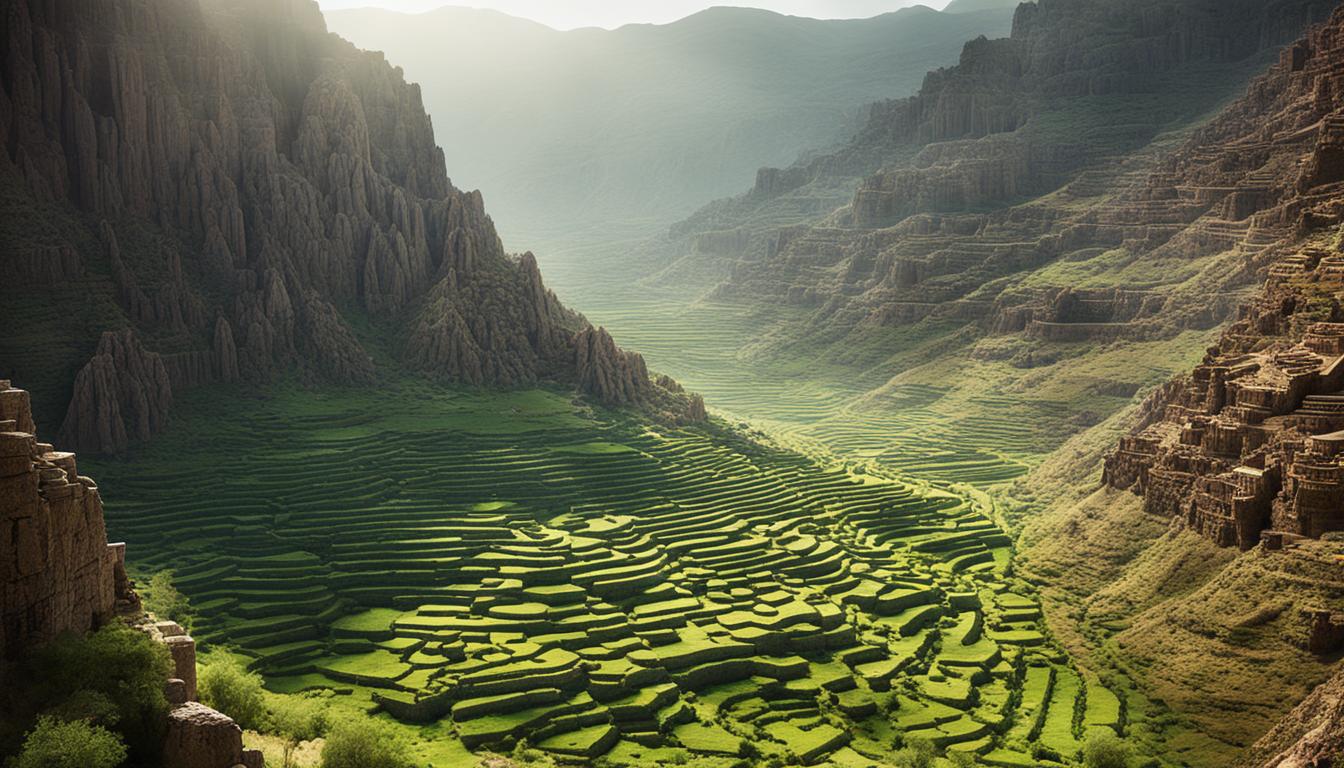







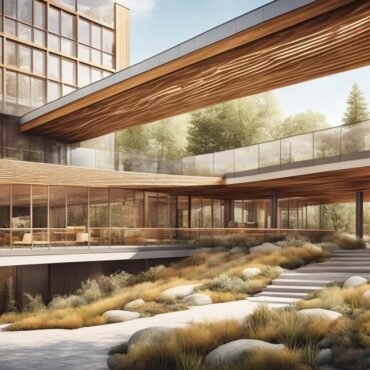










Post comments (0)